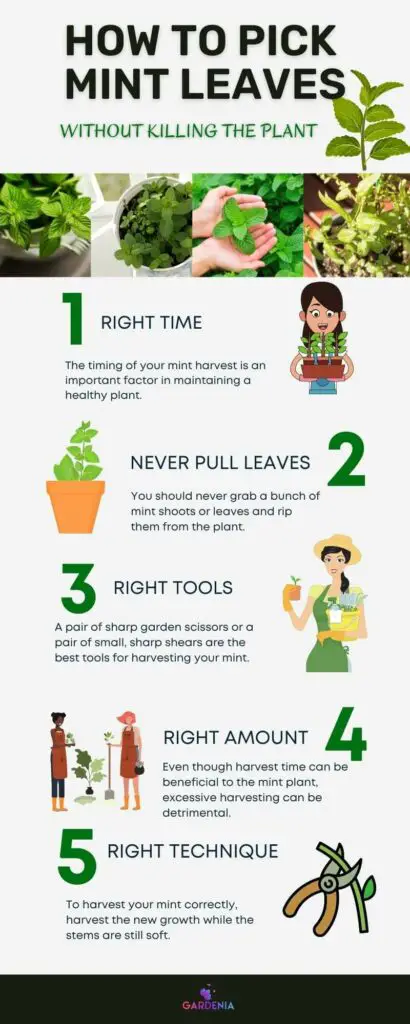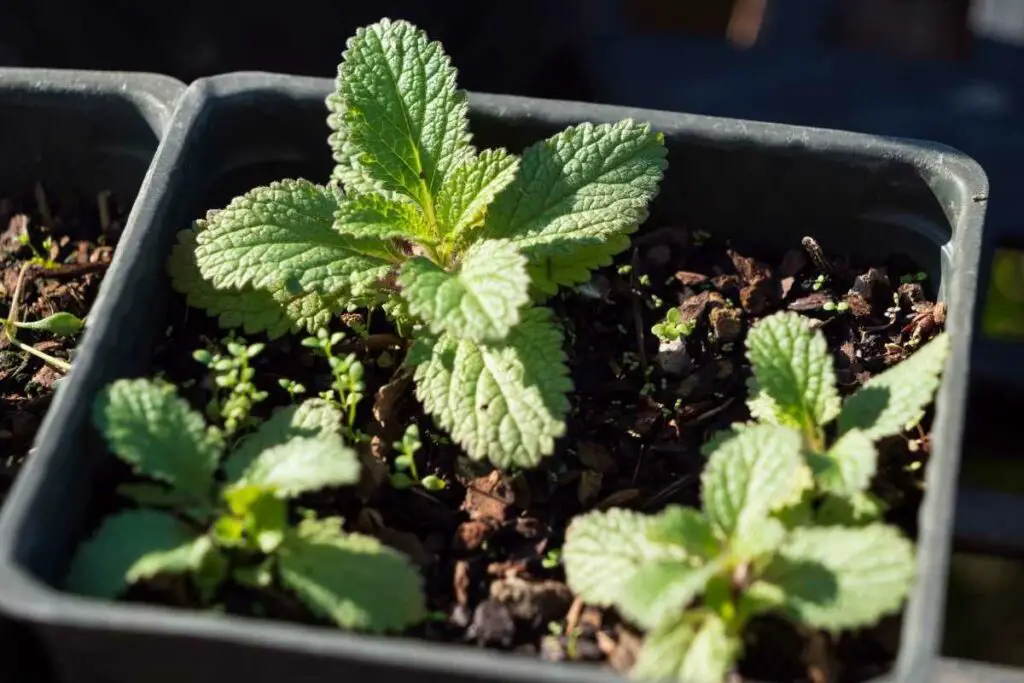Mint is a versatile, easy-to-grow plant that many beginner gardeners choose as a starter crop along with other easy plants such as lettuce and radishes.
Mint is easy to care for and, with a little management, will reward you with beautiful, flavorsome leaves all season long! Is there a wrong way to harvest mint and a right way to avoid damaging the plant?
Mint can be harvested without killing the plant by harvesting at the right time, using the right tools, harvesting the right amount, and cutting the stems rather than pulling the leaves and stems off the plant. Harvesting new growth from the mint in the early morning will give the best results.
Mint is probably one of the hardiest plants in your vegetable and herb garden, but you should still ensure that your harvesting method doesn’t damage the plant.
Be Careful: Incorrect harvesting can damage the plant, causing it to die or injure, making it susceptible to disease and producing a substandard crop.
How to Pick Mint Leaves Without Damaging the Plant
Mint is a very forgiving plant, making it ideal for beginner gardener to practice their cultivation techniques!
Even though mint is a hardy, robust garden plant, you should still practice safe harvesting protocols with your mint plant to avoid unnecessary trauma which could potentially kill the plant.
We have put together some guidelines for harvesting your mint to keep the plant flourishing throughout its growing season and provide you with a constant supply of fresh succulent leaves.

Harvest at Mint the Right Time
The timing of your mint harvest is an important factor in maintaining a healthy plant.
If your mint plant is a new addition to the family, you should give it at least 10-days to 2-weeks to settle into its new environment before considering harvesting from the plant.
Transplanting any plant causes it to go into shock, which is why many plants wilt after being transplanted. Newly planted mint must be given time to overcome the transplant shock and establish itself in the new environment.
Harvesting too soon from the plant will add trauma to the transplant shock, and it can make the plant weak and susceptible to disease or diminished growth as a result.
Once you have given your mint a settling-in period, the best time to harvest some leaves is in the early morning.
This time of day is when the leaves are freshest, most succulent, and full of essential oils for superior flavor.
Key Takeaway: Once the sun is well up in the sky and the heat of the day sets in, the leaves lose moisture, and the essential oils in the leaves lose their intensity, reducing the freshness of the leaves and their flavor potency.
Never Pull Your Mint Leaves to Harvest
As a new gardener, you may be wandering around your garden and see your mint growing well, and you decide to harvest some to flavor your meal.
You should never grab a bunch of mint shoots or leaves and rip them from the plant. This ripping can damage the stems of the plants and even damage the roots of the plants if you pull hard enough. The harvested leaves can be crushed in your hand, causing the flavor to seep out of the leaves.
Bruising and crushing the leaves can cause them to wilt and lose flavor and texture before you get to use them in your meal.

Pulling too hard on the mint plant can dislodge the roots or damage the roots, making the plant vulnerable to pests and diseases and diminishing the plant’s nutrient uptake ability.
This can lead to a weak, unproductive plant that could take a while to bounce back.
Use the Right Tools to Harvest Your Mint
Using the right tools to harvest your crops of herbs and vegetables contributes to preserving the flavor of the harvested section and prevents unnecessary damage to the plant.
A pair of sharp garden scissors or a pair of small, sharp shears are the best tools for harvesting your mint. Dull cutting instruments will cause bruising of the stem being cut and the plant left behind. Cutting with a knife requires bending the stem over, which also causes bruising.
Some gardeners use the pinch method to harvest the soft young mint stems.
This requires pinching the soft stem between thumb and forefinger and using your thumbnail against your forefinger to cut through the stem.
While this method is quick, it also bruises the stem, which can be detrimental to the plant.
Harvest the Right Amount of Mint
The hardiness of mint allows it to be harvested quite aggressively without the plant suffering any ill effects.
Harvesting frequently and aggressively can stimulate the plant to grow denser and more luscious leaves.
Even though harvest time can be beneficial to the mint plant, excessive harvesting can be detrimental. Mature plants can be harvested by taking up to two-thirds of the leaves on the plants. This amount of aggressive harvesting may not be good for a new plant.
When harvesting from your for the first time, you should not take more than one-third of the leaves to avoid stressing the new plant.
If your new plant has been in its pot or the ground for a month, you can get a little more intense with harvesting and take up to half of the new growth on the plant.
Taking too much of the new growth too soon can deprive the plant of the necessary resources to establish itself properly, and it may produce a sub-standard crop and no longer be a strong, healthy plant.
How to Cut The Leaves to Harvest Mint
While your mint plant is a trooper and will survive most harvesting mistakes, you want to harvest to protect the plant and stimulate further growth rather than stunt the plant’s growth.

To harvest your mint correctly, harvest the new growth while the stems are still soft. Leaves on hard, brown stems will be tougher and have less flavor than the new growth. The best place to cut mint is just above a leaf node on the stem. This promotes new leaf growth at this point.
Cutting the stems just above a root node will stimulate new leaf growth from the node below the cut and cause bushier growth of your mint plant.
What To Avoid: Harvesting stems at the top of the plant will also discourage the plant from flowering too soon. Once the mint flowers and produces seed, it will die back in preparation for its dormancy season.
What to Do When You Mint Dies Back
At the end of your mint growing season, the stems will be brown and woody.
The plant will look a little scraggly and sparse. Now is the time to prepare your mint plant for the next growing season.
After the growing season, once your mint has started to die back, drastically prune the plant by cutting it off one inch above the soil’s surface. This may seem harsh, but it will allow the plant to rest during the dormancy and flourish even stronger in its second growing season.
Mint benefits from deep pruning at this stage of its growing cycle, but many new gardeners are too afraid to be this drastic with the plant’s pruning.
You can rest assured that this heavy pruning will not damage the mint but will make it grow even stronger in the next season.
Conclusion
Mint is not only an easy plant to grow, but it is very useful in the household.
From flavoring food to preparing pest repellants for your other garden plants, mint has a ton of uses in your home and garden.
Treating your mint right and practicing proper harvesting techniques will ensure the health and productivity of your mint plant and reward you with a plentiful harvest all season long!
Also Useful
- How to Grow Celeriac from Cuttings?
- How to Choose the Best Fertilizer for Brussel Sprouts
- How to Harvest Oregano without Killing the Plant
